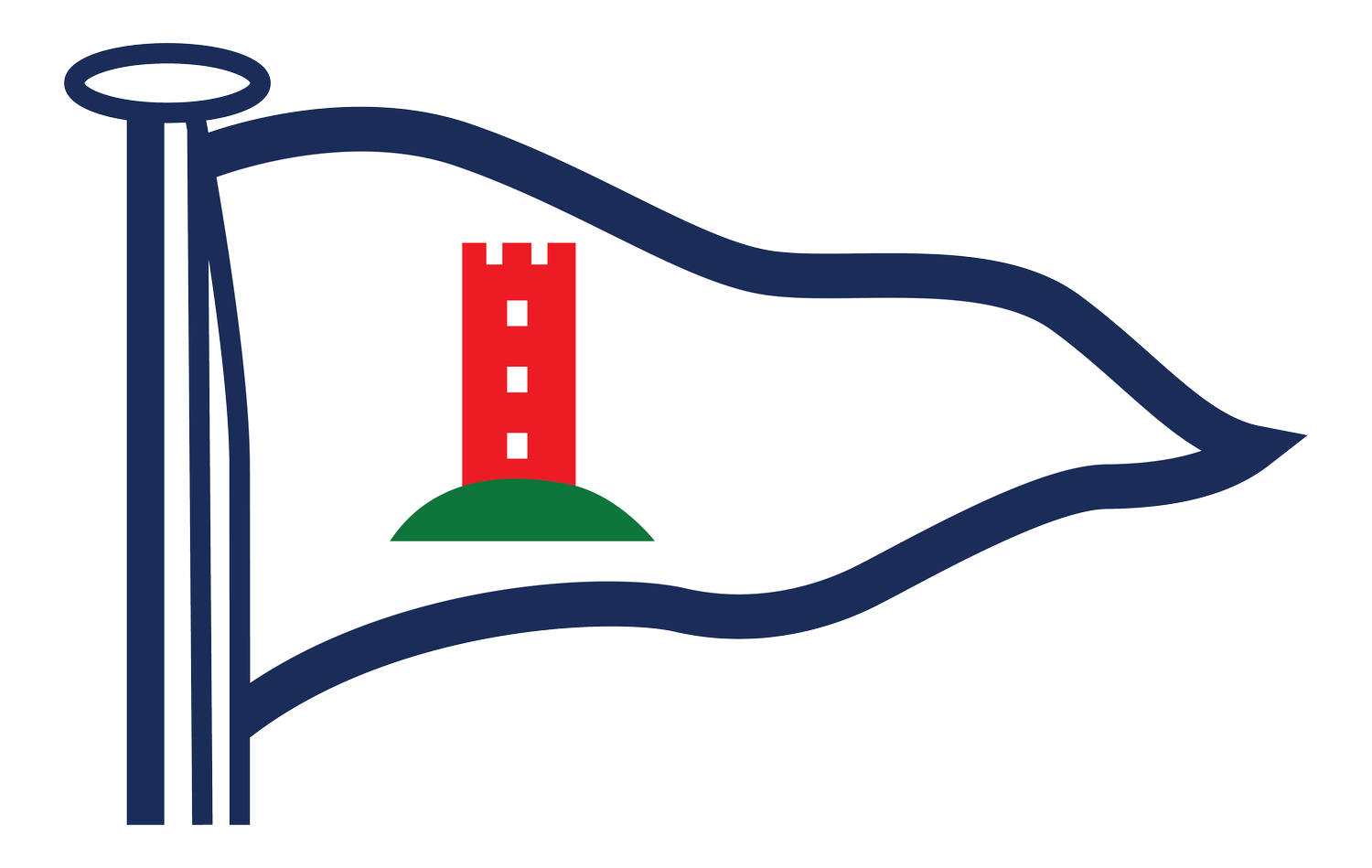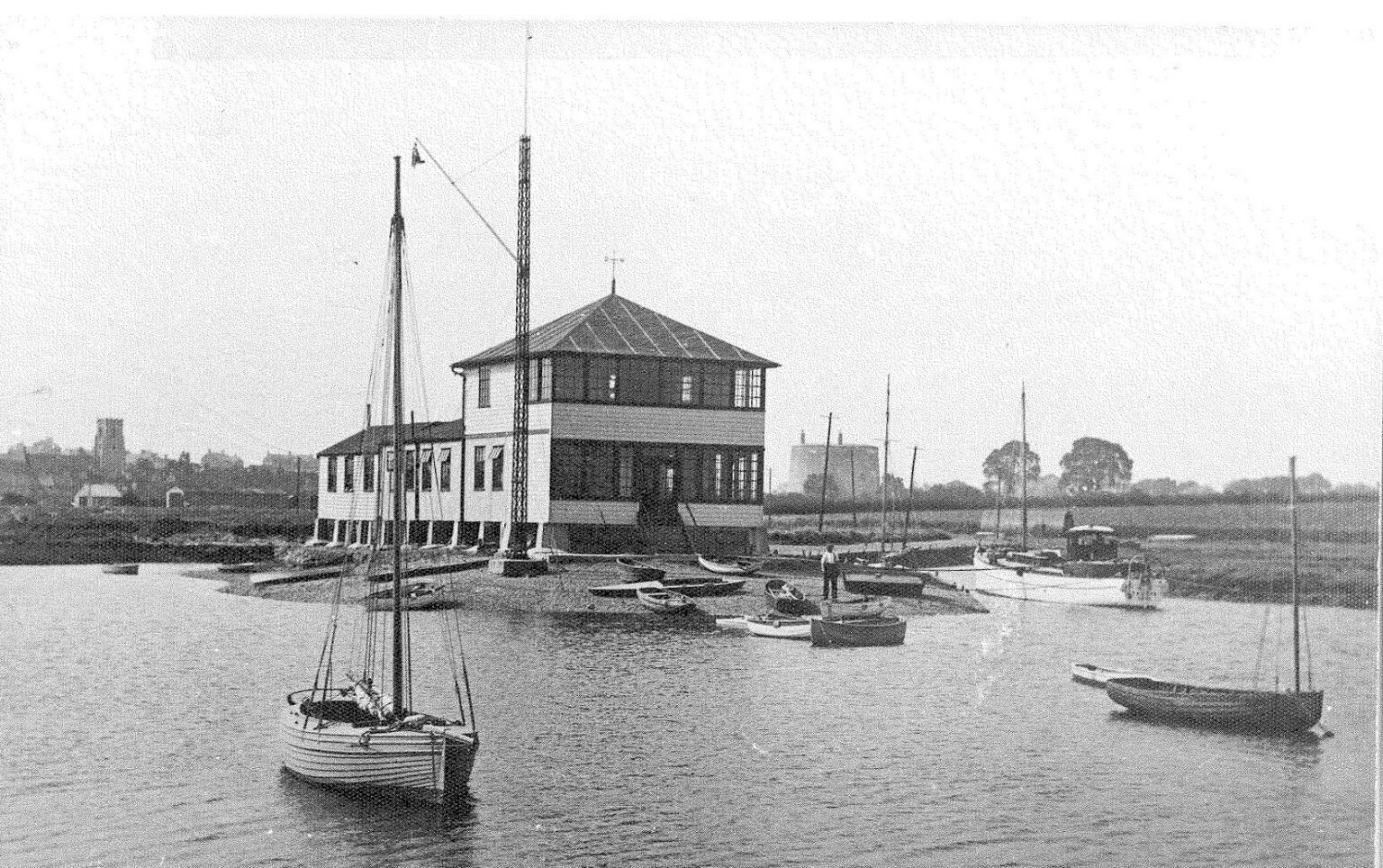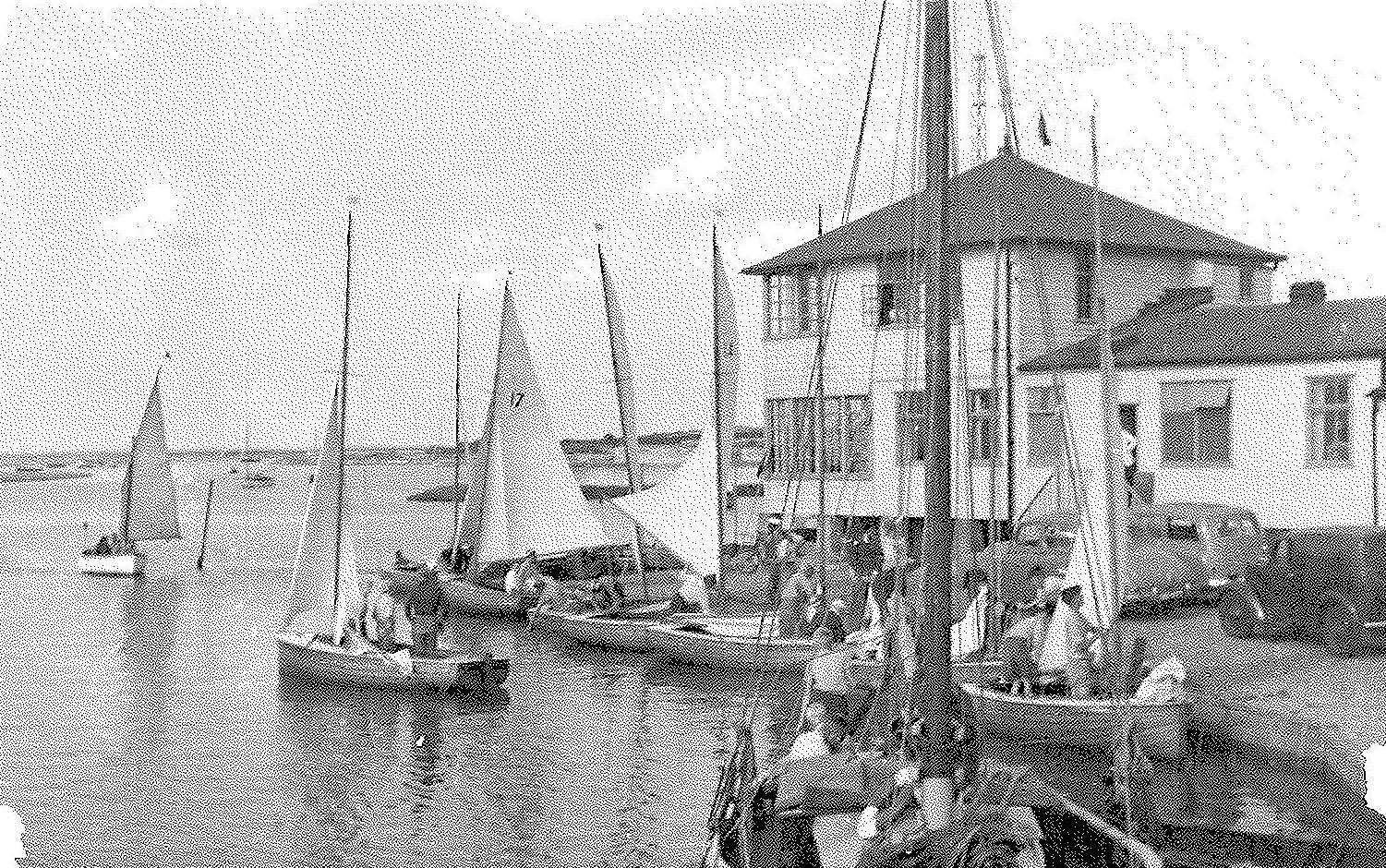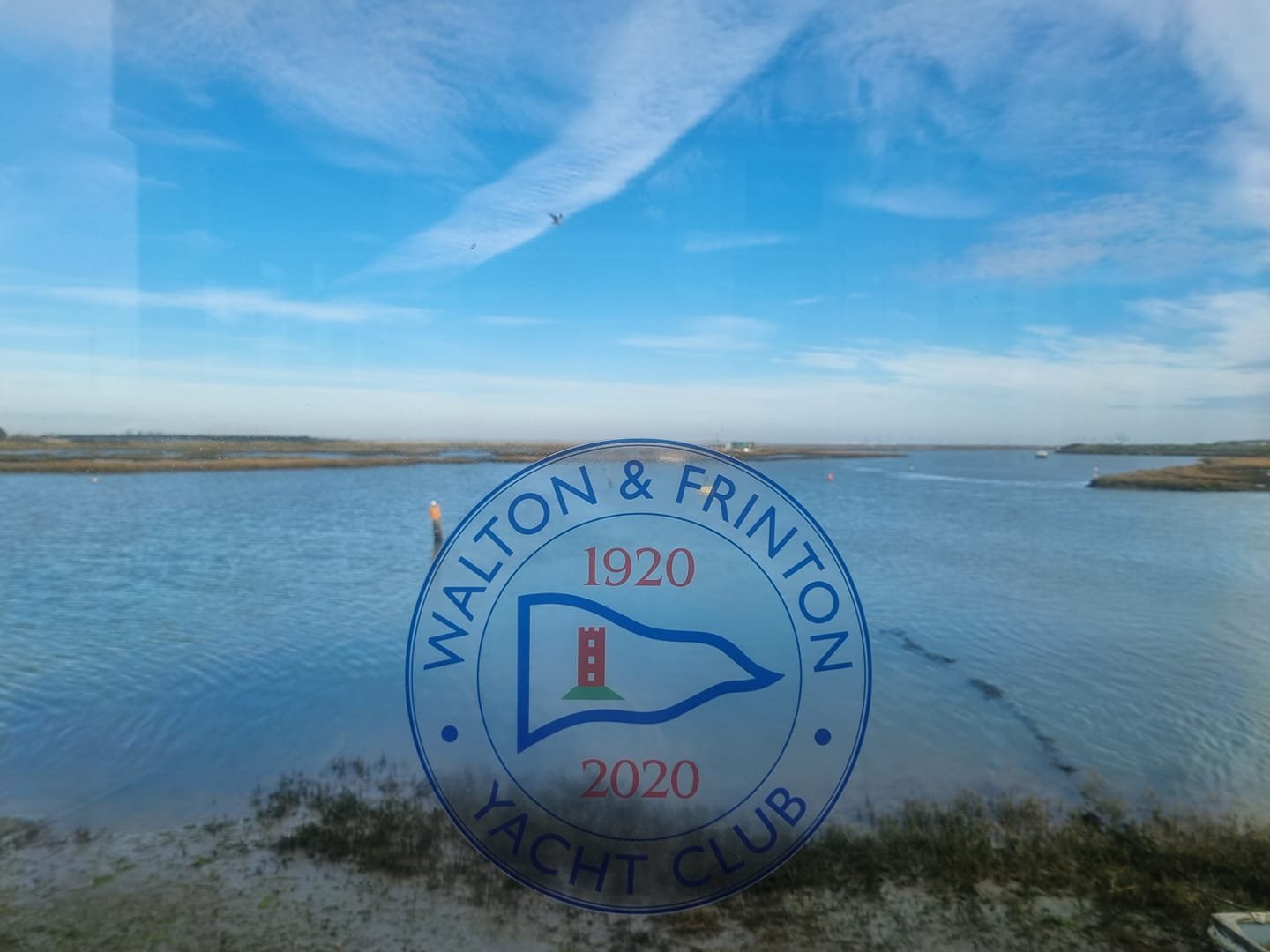History
The Formation of the Walton-on-the-Naze Yacht Club
The first General Meeting of the Walton-on-the-Naze Sailing Club was held at the Albion Hotel, Walton, on 20th September 1910. Shortly after that, it moved into a rented club room, above what was the Fire Station at the top of Mill Lane (part of the old Town Hall complex). The club room was open on Wednesday and Saturday afternoons during the winter months and daily during the summer. The club subscribed to the yachting magazines and purchased books to form the basis of the club library.
Its objective was “to encourage yacht racing and cruising in local waters, to improve the navigation facilities in these waters and to promote the association of those interested in yachting”. The burgee, featuring the Naze Tower, was as it is today.
On the water
Crab Knoll buoy must have been in existence before this time as one of the first acts of the new club was to authorise Mr W Hammond, a local boatman, to “put the chain in order”. It then appointed a sub-committee to carry out the buoying of the Channel inside the Pye Sands, and to meet Mr Woodruffe Eagle to view the site of the proposed new hard “above the Twizzle”. The Hon. Sec. wrote to the Elder Brethren of Trinity House “praying them to put a big buoy on the end of the Pye Sands” but received a reply that they were unable. Later, in December 1915, Mr Hammond was offered £1 to replace Crab Knoll buoy, recover one escaped buoy and sort out mooring chains.
The new club was keen to promote the newly buoyed Backwaters as a yachting venue and contacted the various publishers of pilot books and magazines and other clubs to publicise the new facilities. The racing of the day was often against other local clubs, but the members also held regattas locally. The Opening Regatta, to be followed by a luncheon and prizegiving, was held on Easter Saturday 1911 with all yachts required to assemble between the former Windmill and Watermill at 11.15 am to receive sailing instructions.
There was obviously a very active sailing programme in the local area and many events were held or attended over the next few years, however the First War reduced this number, and members on active service were excused payment of their subscriptions. It is likely that, over the rest of the war years, this put the club into a bit of financial difficulty. It also seems that the Channel buoyage suffered during this time. While the Committee was trying to find and lay replacements, in 1919 an Admiralty Notice to Mariners was published saying that all except for two black buoys that remained “be expunged from the charts”.
In May 1918, it had been agreed that a small buoy be placed at Pye End, but that more buoys need not be put down as the channel was already “well marked by beacons”. During the following year, at the time of the Notice to Mariners, the committee arranged that Pye End, High Hill and Crab Knoll be replaced with larger buoys and that smaller buoys be put back in the old places, as marked on the chart, “if funds allowed”.
The transformation to the Walton & Frinton Yacht Club on its present site
The club house is built on the site of a former windmill. This photo, looking north, was taken c. 1910. A windmill stood on the site for the Clubhouse when it was aquired in 1920. Its foundations are still visible below the dining room.
In June 1919, a small group of members was appointed to meet with the Walton Mill Estate and Harbour Co. to discuss the usage of the quay and right of way to the waterside. The results of these negotiations are not minuted, but it is apparent that the members were given the opportunity to purchase the land for £350.
On September 22nd 1919 a General Meeting was held to agree the proposed new Yacht Club. By this time, £2,355 had already been pledged by 22 members.
The proposals included renaming the club the Walton & Frinton Yacht Club and erecting a club house on the site of the “Windmill on the Backwater” with associated “hards” to enable members to get to their yachts at all states of the tide (one alongside the club house and also what became Colonel’s Hard in the Twizzle with a pathway to it). The estimated cost for all this, including the purchase of the land, laying on electricity and water and furnishing the building was £3,615.
A few days after this meeting, the Committee agreed that “the scheme should be a Limited Liability Company of £5,000 with the proviso that no shares could be transferred by any subscriber without the consent of the directors”. The purchase was to be financed by offering shares to members and thus the Walton & Frinton Yacht Trust was formed.
The documents refer to the purchase of the Hydrophone Station and Listening Post on the seafront, which was dismantled and re-erected on brick and concrete piers on the site of the former windmill. This became the Tower and still stands today. There is no mention of the Army huts that formed the rest of the club house, to the south of the Tower.
In May 1920, the House Committee met in the Marine Hotel and agreed the purchase of furnishings, including 9 mattresses for the bunk room, 9 pillows, 36 blankets and a large number of towels. Also cutlery and crockery, glasses and so on. They then discussed furniture and fittings to be purchased. These are listed by room: Ladies Room, Kitchen, Lavatory, Bathroom, Bunk Room, Committee Room, Reading Room and so on. The total cost of this comprehensive list of items was £126 7s 6d.
At the same time, applications for the post of Steward and Stewardess were coming in and the House Committee was given the job of reviewing these. A sub-committee of three members visited Westcliff to see Mr and Mrs Musselwhite. Once the Committee had approved their appointment, the Musselwhites were notified by telegram.
The whole build was completed very quickly, allowing the members to move out of the club room above the Fire Station and into their new building less than a year after the first negotiations to buy the land. The new club house was opened by the Commodore, Woodruffe Eagle, on Saturday 24th July 1920.
Finishing touches to the club house are noted in minute books. For example, lady members were invited to form a sub-committee “for the purpose of raising funds for the purchase of a flagstaff for the Club House”. In August 1920, Messrs Woodruffe Eagle and John Conly were asked to negotiate the purchase of a billiard table from the Albion Hotel.
On the water
The committee decided to adopt the Morgan Giles’ proposal for an 18ft gaff rigged one design around 1921. Brooke & Halls (the forerunner of Frank Halls & Son Ltd) started building the first boats and racing began in 1922/3. Two of the 18’ Walton One Designs are still being sailed in the Backwaters today (White Heather and Surf). A third, Bilanbil, is awaiting restoration!
Between the wars, in addition to the 18’ Walton One Designs, members raced in smaller 11’ 6’’ Gem dinghies with a single gaff sail.
The Second World War
Above photo: By the mid-50s a fleet of some 15 Jewels, another Walton One Design that was racing alongside the 18-footers, and is still racing today.
During the first year of the war, the various committees met with decreasing regularity. It is apparent that many members were leaving the area to fight, and movements on the water were becoming restricted.
The Committee met in March 1945 for the first time for nearly five years. The Commodore explained that the club had not been requisitioned but it was practically taken over by the Admiralty. It had been run throughout the War by the Stewards, Mr and Mrs Aldridge, with the Commodore, W J Oxley, and local members mucking in to keep the building going.
It seems unlikely that the Channel was marked throughout the war and in February 1946 the Committee met to discuss replacing the missing Channel buoys and agreed that “four buoys only be obtained, two Port and two Starboard and beacons should be placed around Mussel Scarf and Island Point sides of Channel”. Meeting minutes note the approval to purchase chain, and also the reinstatement of the flag mast and that “an estimate be obtained to recondition the piano”.
In 1946, the Sailing Committee adopted a design by Robert Stone for a 14’ half-decked Bermudan rigged dinghy. It was named the Jewel, as a successor to the Gems. The first eight of these Jewel dinghies were built by James of Brightlingsea in time for the 1947 season. More followed, until club members had over 20 of this class, which were also adopted by other clubs.
Aerial view taken in the mid 1950s showing houseboats on the Round Meadow
Major Ground Works
The club house and west quay in the mid 1960s
In the late 1950s / early 1960s, the made-up ground on which the club house quays and hards were built was slipping into the creek.
Tony Fetherston (as Captain and subsequently Commodore) came up with an ambitious programme, first to rebuild the quay on the west side with reinforced concrete and tiebacks into the area of the base of the windmill, and subsequently a similar wall on the east side replacing the Jewel hard with the pontoon basin. All this work was done by a dedicated band of volunteers over a number of years, including John Spong, Martin Wilberforce, Ian Miller, all the Dale family, John Day, Margaret & Terry Sandell and Chris Brooke.
Thanks to the Fetherston family, this team had the use of a formidable collection of construction equipment, which included an excavator (Gert), a dump truck (Daisy), concrete mixers, a fire pump and latterly a small WWII landing craft (Cleopatra). All this construction is still in place today.
In addition, the car park was extended and the first dinghy slip was built on the east side of the club house, filling in the hulk of the Thames barge Plantagenet, once owned by Vic Scammel. An area was also dredged (by a machine built by Jock Smith and powered by a Seagull outboard) for the dingy pontoons. The first pontoons were concrete tanks built by the same team.
The Yacht Basin
By the early 1970s, that various house boats had moved out of ‘Round Meadow’ to the south of the club house. The area was dredged, a flap-gate installed and the yacht basin was formed by the Walton & Frinton Yacht Trust. Over the years, concrete walls and floating pontoons have replaced the original timber staging.
1970s Club House Redevelopment
In late 1977, the Committee (led by Commodore Edgar Traylen), embarked on a major reorganisation of the club house. In particular, the stewards’ quarters (which shared kitchen and bathroom facilities with the members) were not fit for purpose.
In order to maintain a live-in steward, a new purpose-built stewards’ bungalow was constructed in 1978 on the site of the old locker shed (which was moved by crane to its current site) and the club house interior was redesigned to provide better facilities for members. These included the provision of a shower and changing room for the ladies, who previously had only had a WC. The works were funded by gifts and loans from members, plus help from the brewery and the Sports Council.
The bungalow is still in place, but now used as a training room and office, following the departure of the last live-in steward in around 2012.
Club House Redevelopment - 2010 Onwards
By the early 2000s, the low central section of the club house (between the Tower and bungalow) was beyond economic repair. In particular, the kitchen and changing rooms were at the end of their design life.
Various modest schemes were put forward to improve this section of the club house. However, in 2010 a group of members started to explore more ambitious options. A New Build Sub Committee was formed in 2011, led by Commodore David Cocks. Mole Architects (a practice based in Cambridge) was appointed to assist with the design and layout of the building. Members were consulted on various different options and, at an EGM in April 2012, voted to go ahead with a two storey infill extension.
Fundraising was an integral part of the process and a Fundraising Sub Committee was formed. The club was also very fortunate to be awarded grants (including those from Sport England and Essex County Council) and very generous donations from members.
Planning permission was granted by Tendring District Council in July 2012, followed by a separate Flood Defence Consent in December 2012.
The club appointed a firm of quantity surveyors (Daniel Connal Partnership) to help with the tender process. Hills Construction was appointed as main contractor. Robert Leeds (structural engineers) advised on piling and foundations. Hills Construction took approximately 18 weeks to carry out the demolition and foundation works and create a weathertight shell. The building was handed back to the club at the end of August 2013. Martin Jenkins (a dedicated club member) became the Project Manager and completed the fit-out with local sub-contractors and teams of willing club members. The building was officially opened in August 2014, by Commodore Nick Wood.
The new accommodation covers around 420sqm. It is wheelchair accessible (by external ramps and an internal lift), future-proofed against flooding and sensitively designed to fit in with the local Essex landscape. It comprises:
Ground floor – decking, lobby, office, main bar, kitchen, changing rooms / showers and WCs.
First floor – two large function / meeting rooms (The Bill Gibbon Room & The Bill Mayon-White Room), WC and storage / plant room. The rooms are named after two key members who were instrumental in the project.
In conjunction with the new infill section, the original ‘Tower’ (dining room and upstairs bar) and the ‘bungalow’ (offices and training room) have also been refurbished in recent years. Again, this work has predominantly been carried out by club members generously giving their time.
To celebrate our club’s Centenary in 2020, the Centenary Committee embarked on a further project: to refurbish the north balcony. The new glass screens provide an attractive and sheltered place to have a drink and enjoy the views!
We are very proud to have such a wonderful club house overlooking the Walton Backwaters. We hope that the facilities can be enjoyed for years to come.











